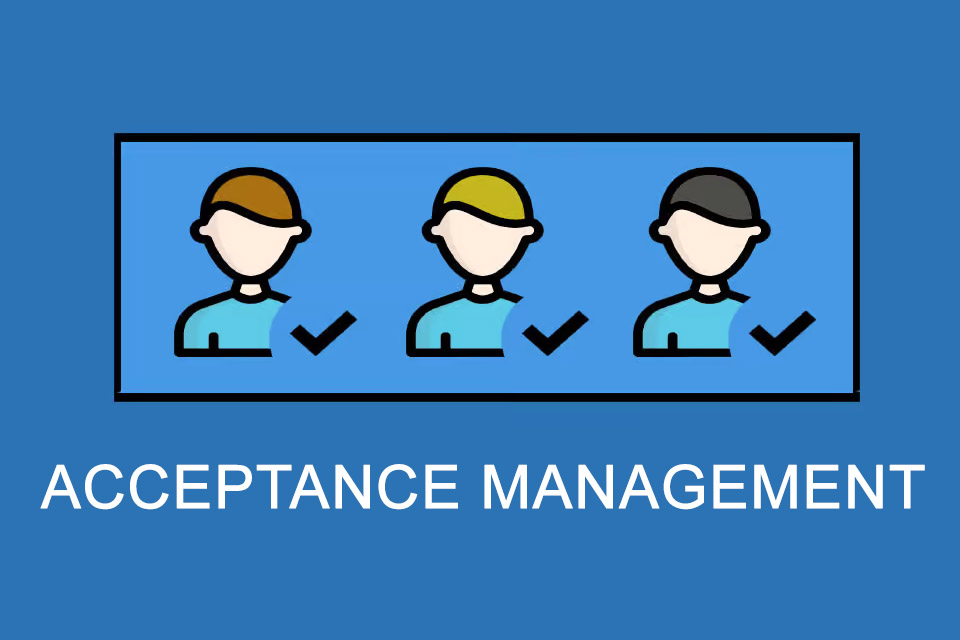What is Acceptance Management?
Smartpedia: Acceptance management designs measures that increase the acceptance of products, technologies, decisions, etc. among directly affected stakeholders.
Acceptance Management – the targeted promotion of acceptance among directly affected stakeholders
Stakeholders are all persons or organisations that are directly or indirectly affected by the activities of a company or have an interest in these activities.
Acceptance refers to the willingness to approve of a state of affairs, to actively agree to the behaviour of people and organisations or to consciously recognise existing conditions.
Acceptance Management plans, designs, controls and optimises measures to promote acceptance by directly affected stakeholders for products, technologies, decisions, processes etc.
Factors that influence acceptance
There are several factors that influence acceptance by affected parties, including:
- Individual benefit: People are more likely to accept something that they individually find useful or valuable, or that aligns with their values and beliefs.
- The degree of familiarity: people are more willing to accept something they are familiar with or have experience with than something that is completely new or unfamiliar.
- The level of support or approval from others: People are more willing to accept something if they see others around them accepting it, or if they receive support or encouragement from trusted sources.
- The amount and reward of effort required: People are more likely to accept something if they feel it requires minimal effort on their part or if they see a reward for their efforts.
- The degree of perceived risk: people may be more reluctant to accept something if they perceive it to be risky, especially if the potential consequences of acceptance are significant.
Organisations should take into account, when specifically addressing Acceptance Management, that these factors are
- individual,
- temporary and
- contextual.
People perceive decisions, features and situations individually. Furthermore, acceptance is temporary and can change over time, e.g. through an increase in information or learning. And last but not least, it always depends on the context. A management decision to lay off employees in a division due to poor forecasts may be accepted by people if they are not directly affected. However, if the context changes, i.e. one’s own division is also affected, the acceptance of the management’s decision is likely to decrease abruptly.
Measures to increase acceptance
In many companies there is no dedicated Acceptance Management. Often there is neither a corresponding department nor a corresponding role. However, this does not necessarily mean that Acceptance Management is not important in these companies. The planning and design of measures to increase acceptance often happens implicitly, e.g. by using good practices, focusing on cooperation in organisations, working in a customer-centred way, etc. There are also numerous methods and practices that are actively used to promote the acceptance of stakeholders – e.g. employees and customers, suppliers and partners, owners, silent partners or shareholders – at an early stage.
Here are some of these methods and practices that implicitly focus on acceptance:
- ROTI feedback is a method for event participants to assess their benefit in relation to the time invested. ROTI stands for Return On Time Invested. Feedback methods ideally promote dialogue among participants and can thus directly increase acceptance.
- A sprint goal describes the Scrum team’s vision for a sprint. It defines the purpose of the sprint and is the basis for the selection of backlog items. The Scrum Team agrees on the goal together – without acceptance this would simply not be possible.
- In the Daily Scrum, obstacles in the work – so-called impediments – are discussed, which have to be removed individually, jointly by the team or with the help of the Scrum Master.
- Fist to Five is a format for asking opinions, in which 6 different hand signals – from a fist (Fist) to the display of 5 (Five) fingers – are possible. From “I veto this decision and cannot support it under any circumstances” (no acceptance), to “I have minor reservations but can live with the proposal” (tolerance), to “I vote for it” and “I am enthusiastic and will actively support its implementation” (acceptance), corresponding degrees of agreement on topics, decisions, procedures, etc. can be recorded.
- All objective formulations, such as SMART, GOOD or SUCCESS, which are made jointly and in consensus, are based on the acceptance of the participants.
- It is similar with practically all ideation approaches, in which ideas for solving tasks or problems are sought jointly. And the use of techniques from requirements engineering, product development or project management, which deal specifically with the needs of stakeholders, are simply inconceivable without acceptance.
In addition to these and similar implicit approaches, there are also methods such as defining acceptance criteria or working with a Definition of Done that deal explicitly with acceptance; but even the use of such approaches does not mean that there must be dedicated Acceptance Management in a company. However, this does not really matter either, because practically all methods that consciously address cooperation in organisations and between business partners are based on acceptance. Acceptance Management is therefore always practised and lived.
Impulse to discuss
What are the possible advantages of dedicated Acceptance Management?
If you like the article or would like to discuss it, please feel free to share it in your network. And if you have any comments, please do not hesitate to send us a message.
Computerwoche writes in an German article that “typically about 10 per cent of the total budget of a project should be planned for acceptance management“. Unfortunately, there is no causal justification for this requirement.
Here you will find additional information from our t2informatik Blog:



